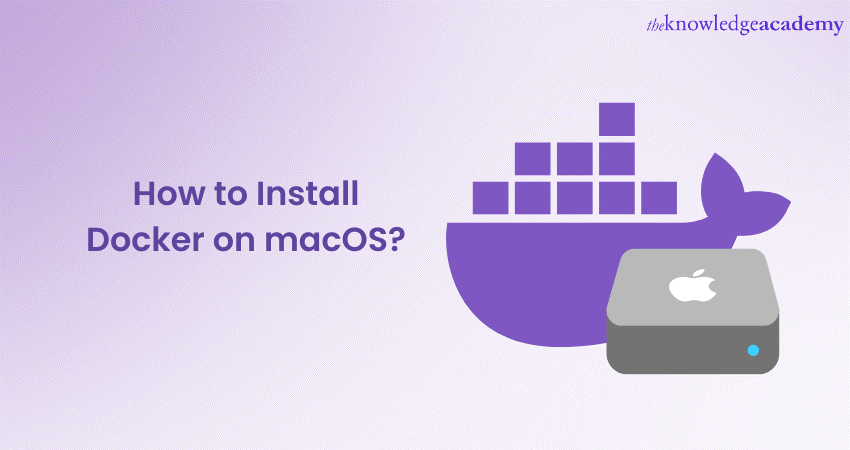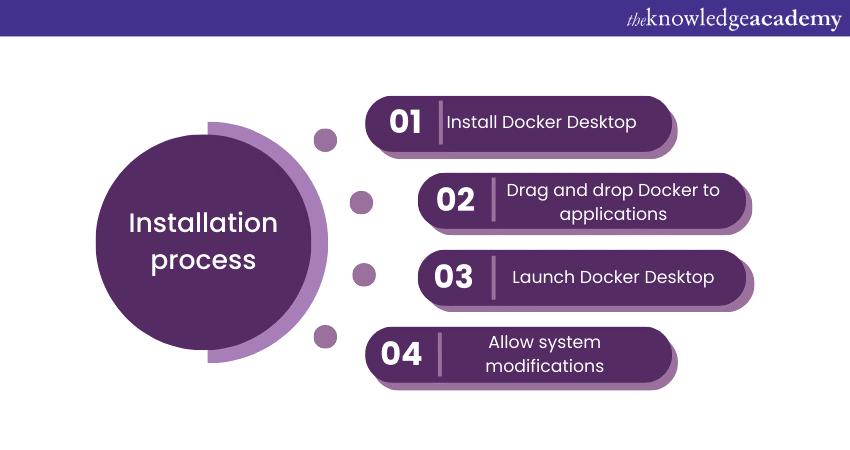We may not have the course you’re looking for. If you enquire or give us a call on 01344203999 and speak to our training experts, we may still be able to help with your training requirements.
Training Outcomes Within Your Budget!
We ensure quality, budget-alignment, and timely delivery by our expert instructors.

Docker on Mac provides a seamless and efficient solution for developers to containerise applications on their MacOS systems. However, installing Docker on Mac can be intimidating for some. Therefore, learning How to Install Docker on Mac is crucial.
By installing Docker on Mac can help you leverage the potential of Docker. By utilising Docker on Mac, developers can overcome cross-platform compatibility challenges and ensure consistent performance between development and production environments.
So, if you want to leverage the benefits of Docker on Mac, you have come to the right place. Read this blog to learn How to Install Docker on Mac. Also, read the detailed instructions for a successful Docker installation and revolutionise your development experience on macOS.
Table of Contents
1) What is Docker?
2) What Is Docker Desktop?
3) Installation guide
4) Installation process
5) Configure and verify Docker Desktop
6) Different ways to install Docker
7) Conclusion
What is Docker?
Docker can be defined as a software platform which helps Developers to build, test and deploy applications quickly. The Docker packages software into certain standardise units called Containers which contains everything that software needs to run. These include libraries, system tools, code and runtime.
What is Docker Desktop?
Docker Desktop can be defined as a program that developers can install on their computers. This application makes the use of Docker considerably easier to run software in containers. It provides a Graphical User Interface (GUI), which helps manage Containers, applications and images directly from the personal computer. This application can be used independently or as a complementary tool to the CLI.
It also reduces the time that is spent on complex setups and helps developers utilise the time to create codes. It also takes care of port mappings, file system concerns and other default settings. It is regularly updated, which helps in fixing bugs and security updates.
Installation guide
With Docker, developers can build, test, and deploy applications, knowing that they will behave consistently regardless of the environment in which they are executed. This consistency streamlines the development process, eliminates the dreaded "it works on my machine" problem, and greatly simplifies the deployment of applications to various hosting platforms. Here is a step-by-step guide on How to Install Docker on Mac:
System requirements for Mac with Intel chip
The following are the system requirements for installing Docker Desktop on a Mac with Apple silicon are as follows:
a) Intel-based Mac with a 64-bit processor.
b) Docker Desktop does not support Macs with ARM-based processors (Apple Silicon) at that time.
c) At least 4 GB of RAM is recommended for Docker Desktop to run smoothly. However, depending on the number of containers and their resource requirements, you might need more RAM for optimal performance.
d) Docker Desktop typically requires a minimum of 4 GB of available disk space for installation and basic operation. However, remember that the space required will grow as you create and use containers.
e) Docker Desktop for Mac uses a lightweight virtualisation solution called "HyperKit" to run Linux containers. Therefore, you need a Mac that supports Intel VT-x virtualisation technology.
System requirements for Mac with Apple silicon
The following are system requirements for installing Docker Desktop on a Mac with Apple Silicon are as follows:
a) Docker Desktop with Apple Silicon support required macOS 11 Big Sur or later. Earlier macOS versions were not supported.
b) Mac with Apple Silicon (M1 chip). Docker Desktop is specifically optimised to run on Apple's ARM-based processors.
c) The minimum RAM requirements are likely to be similar to the Intel-based version (4 GB or more), but it is recommended to have more RAM for optimal performance when running containers.
d) With the Intel-based version, Docker Desktop with Apple Silicon support may require a minimum of 4 GB of available disk space for installation and basic operation. However, actual disk space usage may increase depending on the number and size of containers you use.
e) Docker Desktop with Apple Silicon support uses a different virtualisation technology called "Hypervisor.framework" since Apple Silicon Macs do not have Intel VT-x virtualisation. This framework enables Docker to run Linux containers in a virtualised environment on Apple Silicon chips.
Download Docker Desktop
Here is a step-by-step guide on downloading Docker Desktop:
a) Step 1: Visit the Official Docker website, this page will provide you with options to download Docker Desktop for different Operating Systems.
b) Step 2: Choose the correct platform. Since you are looking to download Docker Desktop for Mac, make sure to select the "Docker Desktop for Mac" option.
c) Step 3: Docker may require you to sign in or create a Docker account to access some features and receive updates. If prompted, sign in using your Docker credentials or create a new account.
d) Step 4: Download Docker Desktop. After selecting the correct platform, click the "Download Docker Desktop" button. This will initiate the download process, and the installer package for Docker Desktop will be saved to your default download location.
Installation process
After completing the download, you can follow these steps to install the Docker Desktop:

a) Step 1: Locate the downloaded Docker Desktop installer package (usually named "Docker.dmg") and double-click on it. This will mount the Docker Disk Image.
b) Step 2: In the mounted Docker Disk Image, you will see the Docker Desktop application icon.
c) Step 3: To install Docker, drag the icon and drop it onto the "Applications" folder shortcut. This will copy Docker Desktop to your “Applications” folder.
d) Step 4: After the installation is complete, go to your "Applications" folder using Finder and locate the Docker Desktop application. Double-click on it to launch Docker Desktop for the first time.
e) Step 5: On the first launch, your macOS might prompt you with a security warning to allow the application to make system changes. Enter your system password or use touch ID/face ID to grant permission.
f) Step 6: Docker Desktop may ask you to sign in with your Docker hub account or create a new account. Signing in enables access to additional features and updates. However, you can skip this step if you don't want to sign in.
g) Step 7: Once Docker Desktop is successfully launched, you should see the Docker icon in the macOS menu bar. Docker Desktop is now installed and running on your Mac.
Embrace DevOps to transform your Software Development and deployment processes; sign up for our DevOps Course now!
Configure and verify Docker Desktop
After you have installed Docker Desktop on your Mac, you may need to configure some settings to suit your specific requirements. Here are the detailed steps to configure and verify Docker Desktop:
a) Step 1: Open the Docker Desktop application either from the Applications folder or using the command line (if you prefer).
b) Step 2: You can verify the Docker version by opening the Terminal and running docker --version command; this command will display the installed Docker version, ensuring that Docker is properly installed and operational.
c) Step 3: Click on the Docker Desktop icon in the MacOS menu bar to access the Docker Desktop menu. From the menu, select "Preferences."
d) Step 4: In the Preferences window, navigate to the "Resources" tab. You can allocate more CPU cores and memory to Docker containers based on your system's capabilities and workload requirements. Drag the sliders to adjust CPU and Memory settings as needed.
e) Step 5: In the Preferences window, go to the "Advanced" tab to configure networking options. Docker uses the default bridge network by default. But you can also switch to using a custom bridge network or host network as per your networking requirements.
f) Step 6: On the same "Advanced" tab, you can also configure file sharing between your Mac and Docker containers. Add any directories you want to share with containers by clicking the "+" button and selecting the appropriate folders.
g) Step 7: After configuring your preferences, click the "Apply option & Restart" button at the bottom of the Preferences window. This will apply the changes and restart Docker Desktop with the new settings.
h) Step 8: Once the Docker Desktop restarts, you can test the configuration by running a simple container. Open the Terminal application and try running a test container, such as the "hello-world" container, using docker run hello-world command; If Docker is configured correctly, you should see a message indicating that your Docker installation is working correctly.
i) Step 9: If Docker Desktop is not running, you can start by clicking on the Docker Desktop icon in the macOS menu bar and selecting "Open." Similarly, you can stop Docker by clicking on the Docker Desktop icon and selecting "Quit Docker Desktop."
Become certified DevOps security professional - sign up for Certified DevOps Security Professional (CDSOP) Training now!
Different ways to install Docker
There are other ways to install Docker. Let’s look at some of these processes:
a) Docker.com: In this process, you have to first go to the Docker website and then download it. Then you have to run the .dmg file. Even though this is one of the easiest ways, it is not the best way to install Docker. If you use this process, then the time taken to share files between MacOS and other systems in Containers will be slow.
b) Docker Toolbox: This is an app that is provided by the Docker company for MacOS and Windows. The unique feature that makes this stand out, is the necessity of a VirtualBox, which acts as a supervisor to help Linux run. Hence, Docker is available as another machine in Docker environment. This part of the toolbox contains “docker-compose”, and “Kinematic”, which will help you to manage Containers with the help of GUI. Then you would not need a command line to run it.
Conclusion
We hope that through this blog, you learned How to Install Docker on Mac. Docker Desktop offers a powerful containerisation solution for MacOS users. With its user-friendly interface and seamless integration, developers can efficiently create, manage, and deploy applications.
Become certified DevOps security professional - sign up for Certified DevOps Security Professional (CDSOP) Training now!
Frequently Asked Questions

Yes, Docker is free to use. It is a popular Containerisation platform, which offers free versions. One of the most used free versions of Docker is Docker Personal. This is free for all individuals, small businesses, and non-commercial open-source projects. This is ideal for development, testing, and other small-scale deployment process.

Yes, Docker is safe to use on Mac. Docker for Mac is specifically designed so that it can run smoothly on macOS. It allows Developers to create a development environment for building, testing, and running Containerised applications.

The Knowledge Academy takes global learning to new heights, offering over 30,000 online courses across 490+ locations in 220 countries. This expansive reach ensures accessibility and convenience for learners worldwide.
Alongside our diverse Online Course Catalogue, encompassing 17 major categories, we go the extra mile by providing a plethora of free educational Online Resources like News updates, Blogs, videos, webinars, and interview questions. Tailoring learning experiences further, professionals can maximise value with customisable Course Bundles of TKA.

Discover DevOps courses with The Knowledge Academy, offering Certified SecOps Professional Course, Certified Agile DevOps Professional Course, and Certified DevOps Professional (CDOP) course. Designed for diverse skill levels, these courses provide a comprehensive understanding of DevOps methodologies. Whether you are starting your journey or aiming to elevate your DevOps expertise, immerse yourself in our DevOps blogs to discover more insights!







 Top Rated Course
Top Rated Course




 If you wish to make any changes to your course, please
If you wish to make any changes to your course, please


